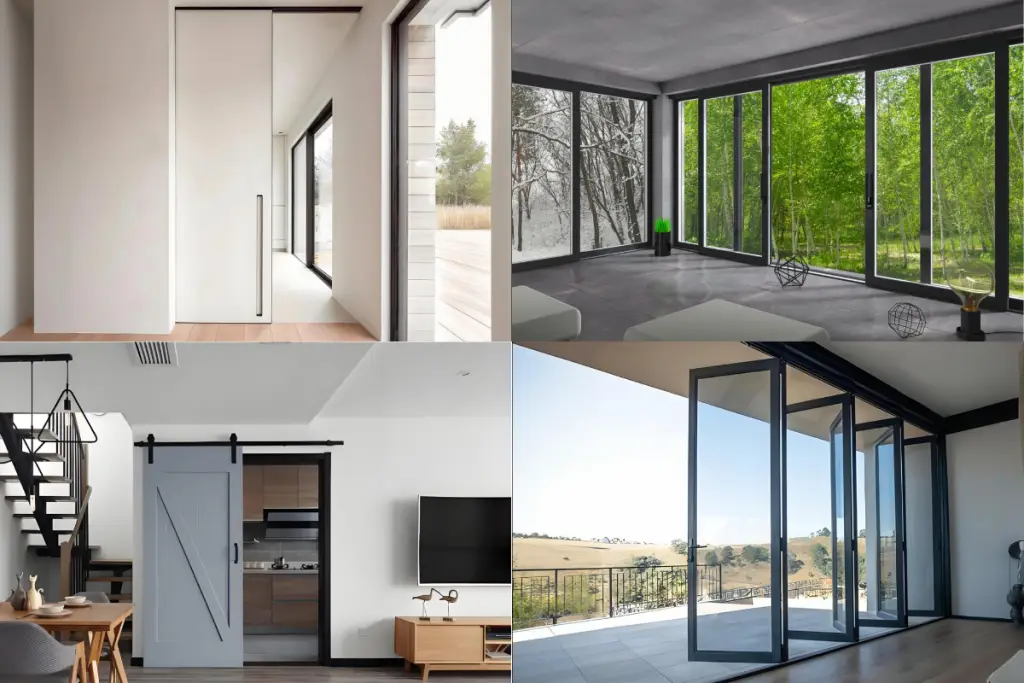bespoke Door and window
- Experienced Door And Window Manufacturer
- Professional Drawing Design Services
- Guidance For Installation
- Home
- Door&Window
Full Solution Windows And Doors For Your Projects
The Leading dOORS & wINDOWS mANUFACTURER
What George Door&Window Offer?
With George, achieving your goals becomes seamless and efficient with just a single step. We understand that every customer has distinct needs and challenges, which is why we prioritize working closely with you to identify the most effective solutions. Our approach is centered around collaboration, ensuring that we fully understand your requirements before delivering a tailored solution.
Our dedicated team of designers and engineers is committed to addressing these challenges with innovative products that are easy to install, simple to maintain, and straightforward to repair. At the same time, we focus on ensuring that our solutions remain cost-effective, providing long-term value without compromising on quality. By partnering with us, you can be confident that you’re not only getting a product that meets your immediate needs but one that will continue to deliver reliable performance for years to come.
With years of engineering experience, our aluminum products have been certified by NFRC, ULC, CSA and AS 2047.
More than 3000+ bespoke fenestration projects in Asia, Middle East, Africa, Europe and America.
George's own production facility supports our ability to offer cost-effective solutions to our customers.
Professional team to provide guidance on installation services.Door to door service when necessary.
Find Your Project Solution
George Windows and Doors are designed to reflect a variety of lifestyles. We respect your vision and, based on your ideas, craft tailored products at no extra cost. Whether you are renovating a historic home or building your dream residence, George offers an array of styles and profiles to suit your needs. Explore our collection for inspiration, and we will bring your imagination to life.
By Opening Type
Windows
Picture/fixed
Hinged
Sliding
Single/Double hung
By Material
Doors Options
Sliding Door Collection
Sliding doors are commonly made from conventional materials such as wood and aluminum. Wooden sliding doors are typically used in interior hallways, storage areas, and closet. Aluminum sliding doors, though also suitable for interior spaces,also used for balconies, patios, and other outdoor areas. Folding doors are a type of sliding door that can be opened by folding, thereby expanding the passageway width and minimizing the space occupied by the door.

swing Door Collection
Wooden
Aluminum
Iron
Inspiration Your Bespoke Projects
Send us your window and door drawings via Whatsapp, email, etc. Our team will adapt your drawings and product design to provide functionality, design, technical and installation services according to temperature and climate in your country.
Upon receipt of your window or door drawings or requests, our team will customize a detailed design plan, create preliminary design drawings, and then work with you to determine material, color, and hardware options.
After the design plan is confirmed by you, our production workshop will follow the order details to customize high-quality raw materials and hardware, and then production with the size, color and other details of the doors or windows base on the drawing.
After the goods are completed, our quality inspector will inspect the products to ensure the size, function and design are consistent with the order. The inspection photos or videos will offer to you for confirmation.
Why George Window And Door?
experienced custom fenestration manufacturer
George is a premier manufacturer of fully custom fenestration systems, dedicated to bringing your vision to life. We offer complete design freedom for your windows, doors, and more, with no extra charges for unique shapes, hardware styles, or color selections. Your vision inspires us, and our mission is to transform it into reality.
Each of our products is meticulously crafted to meet your local building codes and inspection requirements, ensuring safety and durability you can trust. Choose George for an unparalleled bespoke fenestration experience.


Design Assistance & Advice Service
We manage the entire process on your behalf, from start to finish, leveraging our in-house expertise to deliver seamless results. Our services include complimentary design development and contract documentation, complete with CAD and BIM drawings. Alongside detailed elevation and installation designs, we verify that all products align with project specifications through visual confirmation via photos or videos. Additionally, we coordinate the delivery schedule and logistics, ensuring cost-effectiveness throughout the project.
The Safety & Efficient Delivery
Each door and window is meticulously wrapped in multiple protective layers and then expertly secured within the container by our skilled shipping team. We employ extensive stabilization measures to ensure that, even over long distances, your products arrive at your site in pristine condition.
With years of experience and tens of millions of dollars in annual exports, George has built a reputation for quality and reliability in delivering windows and doors worldwide. We understand that proper packaging is essential to prevent damage during transit, and we prioritize what matters most to our clients: the safe arrival of their products.

Customize Your Project
Trusted By
Through Collaborations And Partnerships,we Amplify Our Impact






Doors And Windows Solution FAQS
1. Coordinate with Framing Completion
- Timing: Doors and windows are typically installed once the framing is complete but before interior finishing begins. This usually falls after the exterior walls are built, but before insulation and drywall.
- Reason: Installing doors and windows after framing provides stability for proper alignment and secure installation.
2. Before Interior Work and Finishing
- Timing: Complete door and window installation before adding drywall, flooring, and final interior finishes to prevent damage.
- Reason: Installing windows and doors earlier minimizes dust and debris exposure to interior elements and keeps installation efficient without the need to work around finished walls and floors.
3. Consider Weather Conditions
- Timing: Plan for installation in mild weather, if possible. Avoid extreme cold or rainy conditions, as these can affect sealants and adhesives, which need time to cure properly.
- Reason: Weather can impact the quality of installation, as certain materials expand or contract with temperature and moisture.
4. Ensure Rough Openings are Correct
- Timing: Before the actual installation, double-check measurements of the rough openings for doors and windows to ensure they’re correct, accounting for any framing shifts.
- Reason: Properly sized openings prevent gaps, drafts, and misalignment issues down the road.
5. Install Exterior Doors Before Insulation and Interior Doors After Flooring
- Exterior Doors Timing: Exterior doors should be installed before adding insulation and drywall to create a sealed envelope, which allows climate control during interior work.
- Interior Doors Timing: Interior doors are best installed after flooring to ensure they don’t get damaged during construction and are properly sized with the finished floor.
6. Plan for Security
- Timing: Once doors and windows are installed, your house will be enclosed, making it easier to secure tools and materials.
- Reason: This also allows you to lock up the site, reducing the risk of theft and ensuring a safe, sealed environment for further work.
Drafts or Temperature Fluctuations
- If you feel a draft near windows or doors or notice rooms are hotter in summer or colder in winter, your windows or doors may be losing insulation. This increases energy costs and can indicate that seals or insulation have worn out.
Difficulty in Opening or Closing
- Warped, swollen, or rusted frames, or broken hardware can make it hard to operate your windows or doors. Not only is this inconvenient, but it can also be a security concern.
Visible Damage or Decay
- Cracks, chips, warping, and other visible damage in frames, sashes, or door panels can affect the integrity of windows and doors, allowing air, moisture, and even pests to get in.
Condensation or Fogging Between Panes
- Condensation or fogging between glass panes often indicates that seals are broken, reducing energy efficiency and insulation. Once the seal fails, the gas that provides insulation (like argon or krypton) has usually leaked out, decreasing the window’s effectiveness.
Increased Energy Bills
- Older or poorly insulated doors and windows can drive up heating and cooling costs. New energy-efficient models are better insulated, helping lower monthly bills over time.
Excessive Noise from Outside
- If you’re hearing much more noise from outside than usual, it might mean the insulating properties of your windows have decreased. Double or triple-pane windows are much better at sound insulation than single-pane models.
Outdated Appearance
- Worn, outdated, or mismatched styles can reduce the curb appeal of your home. Newer windows and doors often come in designs that increase both aesthetic appeal and functionality.
Water Damage or Leaks
- Moisture around your window or door frames, mold, peeling paint, or soft wood can indicate water is seeping in. This can lead to further structural issues if left unaddressed.
Increased Security Concerns
- Older doors and windows might lack the strength and features of modern security technology, like reinforced glass or multi-point locks. Replacing them can improve your home’s safety.
Measuring a Window
Width Measurement
- Measure the width in three places: top, middle, and bottom of the window opening.
- Record the smallest measurement. This is the width to use, ensuring the window will fit in the narrowest part of the opening.
Height Measurement
- Measure the height in three places: left side, middle, and right side of the window opening.
- Again, use the smallest measurement for the height.
Depth Measurement (for Replacement Windows)
- Measure from the inside of the trim to the outside edge of the window frame.
- This measurement ensures the replacement window will fit into the existing frame depth.
Double-Check Measurements
- Double-check all measurements, as even small inaccuracies can lead to fit issues.
Measuring a Door
Width Measurement
- Measure the width of the door frame from jamb to jamb. Do this at the top, middle, and bottom of the frame.
- Record the smallest measurement for the width.
Height Measurement
- Measure from the top of the door frame to the floor at three points: left, center, and right.
- Use the smallest height measurement.
Depth Measurement
- Measure the thickness of the wall where the door frame will sit. Standard door depths are typically around 4 9/16″ or 6 9/16″ for exterior doors, but this can vary based on wall thickness.
Additional Considerations (for Pre-Hung Doors)
- If installing a pre-hung door (one with its own frame), measure the entire opening width and height, including the frame space. This gives room for shimming to ensure a tight fit.
Determine Swing Direction (for Doors)
- Decide if you need a left-hand or right-hand swing door. This depends on which side the hinges are on and which way you want the door to open.
The cost to customize windows and doors can vary widely depending on materials, design choices, size, and any added features. Here’s a breakdown of factors that affect the price when customizing:
1. Material Choice
- Windows: Common materials include vinyl,aluminum and aluminum clad wooden.
- Doors: Choices include wood,steel, and composite. Solid wood doors are often the most expensive, while steel can offer durability at a moderate price.
2. Size and Shape
- Custom sizes or unique shapes (like arched or circular windows) tend to increase costs, as they often require special manufacturing.
- Large windows or oversized doors will also cost more, as they need additional materials and structural suppo
3. Glass and Insulation Options
- Double or Triple Glazing: Standard windows are double-pane, but opting for triple-pane can increase costs by around 20–30%.
- Low-E Coatings and Gas Fills: Low-E coatings improve energy efficiency and can add 10–20% to the window cost. Gas fills (argon or krypton) between panes improve insulation and add a small cost.
- Tempered or Impact-Resistant Glass: Required in some locations for safety, this type of glass is around 15–30% more than standard glass.
4. Hardware and Finishes
- High-end hardware or specialty finishes, like antique bronze or custom handles, will add to the cost.
- Choosing upgraded hardware for doors and windows can add a few hundred dollars per item
5. Custom Design and Styling
- Architectural details like divided panes (grilles), etched glass, or decorative elements can add significantly to the cost.
- Doors with sidelights, transoms, or glass inserts increase both material and installation cost.
6. Installation and Labor Costs
- Custom windows and doors often require specialized installation, especially if they’re large or uniquely shaped.
- Complex installations may involve structural adjustments to fit oversized or heavy doors and windows.
7. Smart Features and Security Add-Ons
- Smart locks, integrated blinds, and security features can be added for enhanced functionality. These are usually optional but can increase the total cost.
Yes,most doors can be repainted or refinished, especially wooden. If you are not sure the color you want, we can finished the painting of base color, and repaint when you receive the door. Also our workshop support to customize the color as RAL standard.
Tempered glass is a type of safety glass treated with heat and rapid cooling to be four to five times stronger than regular glass. When it breaks, it shatters into small, blunt pieces, reducing the risk of injury.
Key Benefits:
- Increased Strength: More resistant to impact and thermal stress.
- Safety: Shatters into less dangerous pieces.
- Durability: Resists scratches and wear, ideal for high-traffic areas.
When It’s Necessary:
Tempered glass is required by building codes in certain areas due to safety concerns, such as:
- Doors and Entryways: Sliding doors, French doors, and storm doors.
- Low Windows: Windows close to the floor or foot traffic.
- Bathrooms and Showers: Tub enclosures and shower doors.
- Stairs and Railings: Glass near stairs or railings.
- Skylights and Roof Windows: Areas prone to high wind or debris.
Low-E (low-emissivity) glass has a thin coating that reflects infrared and ultraviolet light. It keeps interiors cooler in summer and warmer in winter, helping to reduce energy costs.
Common styles include casement, double-hung, single-hung, sliding, awning, bay, bow, and picture windows, each offering different functionality and aesthetic appeal.
We'd Love To Hear From You
contact us
Find us Here
- Jihua 4 road, Chancheng District, Foshan City, Guangdong, China
Phone or Whatsapp
- +86 18029240327

